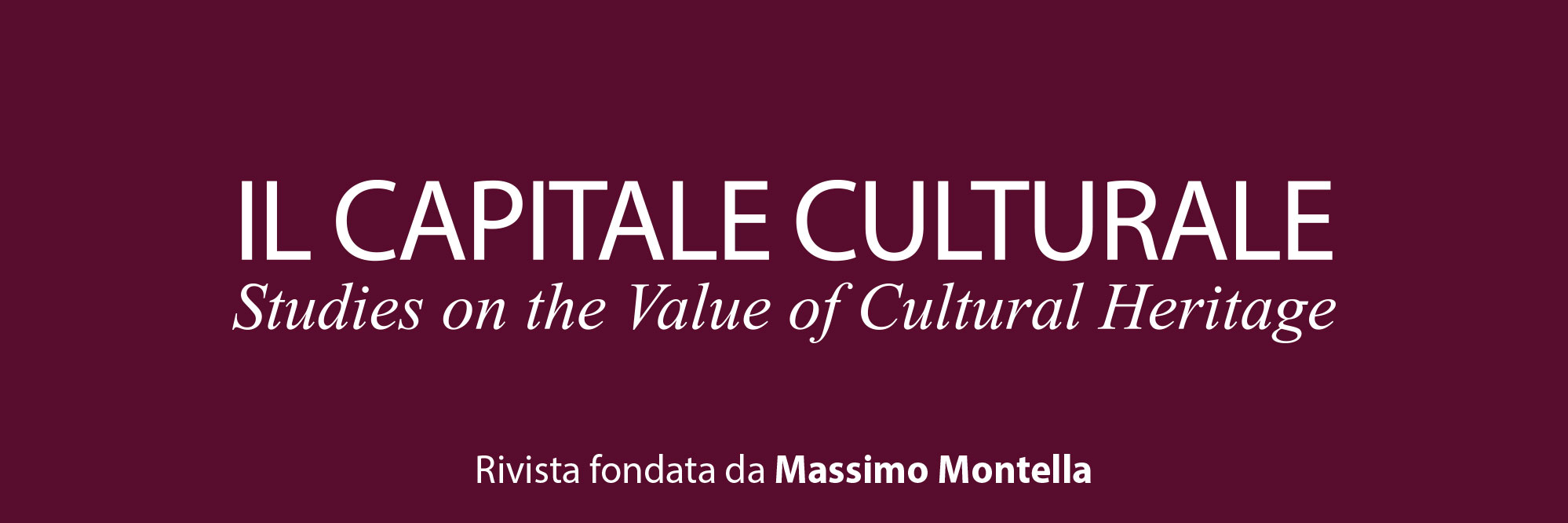Digitalizzazione e patrimonio culturale tra crisi e opportunità: l’esperienza del Museo Egizio di Torino / Digitalization and Cultural Heritage between Crisis and Opportunities: the Experience of the Egyptian Museum in Turin
Downloads
Pubblicato
Fascicolo
Sezione
Licenza
Tutti i materiali pubblicati sono coperti da copyright, mantenuto dall'Università di Macerata che ne supporta finanziariamente e tecnicamente la pubblicazione.
La licenza adottata è la Creative Commons - Attribuzione/Condividi allo stesso modo. Ovvero, gli autori che pubblicano su questa rivista accettano le seguenti condizioni:
- Gli autori mantengono i diritti sulla loro opera e cedono alla rivista il diritto di prima pubblicazione dell'opera, contemporaneamente licenziata sotto una Licenza Creative Commons - Attribuzione che permette ad altri di condividere l'opera indicando la paternità intellettuale e la prima pubblicazione su questa rivista.
- Gli autori possono aderire ad altri accordi di licenza non esclusiva per la distribuzione della versione dell'opera pubblicata (es. depositarla in un archivio istituzionale o pubblicarla in una monografia), a patto di indicare che la prima pubblicazione è avvenuta su questa rivista.
- Gli autori possono diffondere la loro opera online (es. in repository istituzionali o nel loro sito web) prima e durante il processo di submission, poiché può portare a scambi produttivi e aumentare le citazioni dell'opera pubblicata.
DOI:
https://doi.org/10.13138/2039-2362/2532Abstract
A causa della pandemia da Covid-19 i musei hanno subito sia un’improvvisa interruzione delle attività quotidiane, che un duro colpo ai programmi di breve e medio termine. L’improvvisa mancanza dell’interazione fisica e personale che solitamente ruota intorno alla collezione ha imposto l’adozione di connessioni virtuali tra persone, luoghi e oggetti. Chiamati a sostituire temporaneamente le interazioni dirette, questi collegamenti virtuali possono tuttavia essere sfruttati in modo ben più complesso e produttivo. Questo articolo descrive brevemente il modo in cui il Museo Egizio di Torino si sta interfacciando con l’ampio ambito della digitalizzazione, con il suo significato e la sua funzione nel contesto di un museo archeologico, nell’ottica di costruire un sistema integrato che combini cultura materiale e digitale.
The pandemic due to Covid-19 disrupted the daily routine of museums, as well as their ability to make plans in the short and medium terms. The sudden lack of human and physical interactions around the collections prompted the adoption of virtual connections among people, places and objects. Called to temporarily substitute the direct interaction, these virtual links can be however exploited in a far more complex and productive way. This article briefly presents the approach of Museo Egizio, Torino to the broad field of digitalisation, its meaning and function in the context of an archaeological museum, towards the construction of an integrated system combining digital and material culture.
Riferimenti bibliografici
Bonacini E. (2012), Il museo partecipativo sul web: forme di partecipazione dell’utente alla produzione culturale e alla creazione di valore culturale, «Il Capitale culturale», 5, pp. 93–125, http://riviste.unimc.it/index.php/cap-cult/issue/view/19 (05.09.2020).
Cerisola S. (2019). Cultural Heritage, Creativity and Economic Development, Cheltenham: Edward Elgar.
Cultural Heritage Counts for Europe (CHCfE) (2015), Cultural Heritage Counts for Europe: Full Report,
Del Vesco P. et alii (2019), Current Research of the Leiden-Turin Archaeological Mission in Saqqara. A Preliminary Report on the 2018 Season, «Rivista del Museo Egizio», 3, pp. 1-25,
Dugdale J. et alii (2020), Human Behaviour Centered Design: Developing a Software System for Cultural Heritage, IEEE/ACM 42nd International Conference on Software Engineering, Software Engineering in Society (ICSE-SEIS), pp. 85-94.
Greco C. (2018), Il museo e la sua natura, catalogo della mostra Anche le statue muoiono: conflitto e patrimonio tra antico e contemporaneo (Torino, 8 Marzo – 9 Settembre 2018), Modena: Panini, pp. 21-27.
Greco C. (2019), Keynote: the biography of objects, «International Archives of the Photogrammetry, Remote Sensing and Spatial Information Sciences - ISPRS Archives», XLII-2/W11, pp. 5–10,
https://doi.org/10.5194/isprs-archives-XLII-2-W11-5-2019 (20.07.2020).
Hati A. et alii (2020), Weakly Supervised Geodesic Segmentation of Egyptian Mummy CT Scans, arXiv:2004.08270v1, 30.07.2020.
Hodder I. (2012), Entangled. An Archaeology of the Relationships Between Humans and Things, Oxford: John Wiley and Sons Inc.
Innocenti N., Lazzeretti L. (2019), Do the Creative Industries support Growth and Innovation in the Wider Economy? Industry Relatedness and Employment Growth in Italy, «Journal Industry and Innovation», 26 (10), pp. 1152-1173.
Lazzeretti L., Sartori A. (2016), Digitization of Cultural Heritage and Business Model Innovation: The Case of the Uffizi Gallery in Florence, «Il Capitale culturale», 14, pp. 945-970.
Lloyd H. et alii (2007), Economics of Dust, «Studies in Conservation», 52, 2, pp. 135-146.
Maddison D., Foster T. (2003), Valuing congestion costs in the British Museum, «Oxford Economic Papers» 55, 1, pp. 173–190.
Mandelli A. et alii (2019), The Digitalization of Ancient Egyptian Coffins: a Discussion over Different Techniques for Recording Fine Details, «International Archives of the Photogrammetry, Remote Sensing and Spatial Information Sciences - ISPRS Archives», XLII-2/W15, pp. 743–750, https://www.int-arch-photogramm-remote-sens-spatial-inf-sci.net/XLII-2-W15/743/2019/, (20.07.2020).
Navarrete T. (2019), Digital Heritage Tourism: Innovations in Museums, «World Leisure Journal», https://doi.org/10.1080/16078055.2019.1639920, 30.07.2020.
Polis S. et alii (2020), Crossing Boundaries: Understanding Complex Scribal Practices in Ancient Egypt (with a 2019 Progress Report), «Rivista del Museo Egizio», 4, https://doi.org/10.29353/rime.2020.2952, 20.07.2020.
Rossi C. (2019a), Immaterial Data and Material Culture; Surveying and Modelling the New Kingdom Necropolis of Saqqara, «Saqqara Newsletter» 17, pp. 61-71.
Rossi C. (2019b), Aristotle’s Mirror: Combining Digital and Material Culture, «International Archives of the Photogrammetry, Remote Sensing and Spatial Information Sciences - ISPRS Archives», XLII-2/W11, pp. 1025–1029,
https://doi.org/10.5194/isprs-archives-XLII-2-W11-1025-2019 (20.07.2020).
Rossi et alii (2020), Digital Workflow to Support Archaeological Excavation: From the 3D Survey to the Websharing of Data, in: Aste N., Della Torre S., Talamo C., Adhikari R., Rossi C. (eds) Innovative Models for Sustainable Development in Emerging African Countries. Research for Development. Springer, Cham. https://doi.org/10.1007/978-3-030-33323-2_13 (20.07.2020).
Stevenson, A. (2019), Scattered Finds. Archaeology, Egyptology and Museums, London: UCL Press, https://www.uclpress.co.uk/products/95150 (20.07.2020).
Thanou A. et alii (2020), A Sociotechnical Approach to the Museum Congestion Management Problem, «IEEE Transactions on Computational Social Systems PP», 99, pp. 1-6,
1109/TCSS.2019.2963558
Yoshimura Y. (2014), An Analysis of Visitors' behavior in the Louvre Museum: A study using Bluetooth Data, «Environment and Planning B: Planning and Design», 41 (6), pp. 1113-1131.




